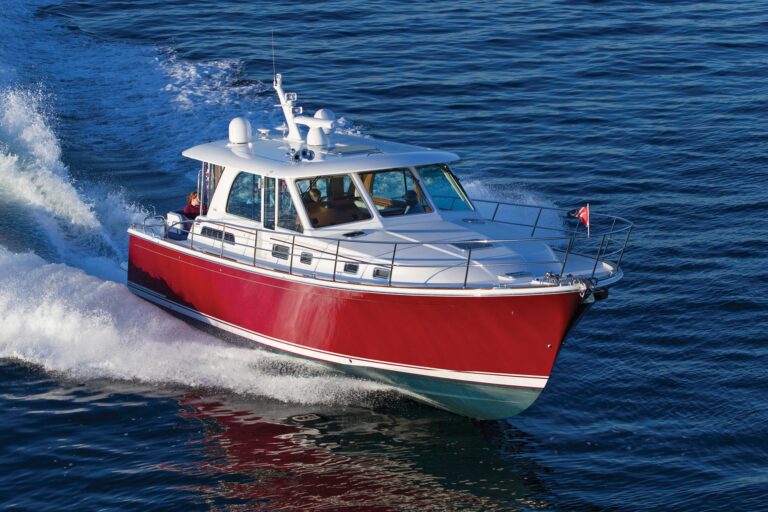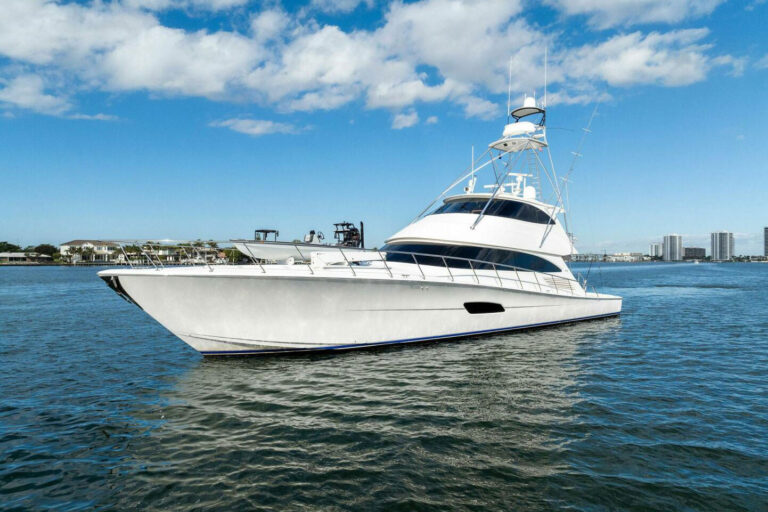
Hull Choices
Things were once so simple. A yacht had one hull, and it was designed to travel at displacement speed. No more. The speed of a displacement monohull is limited by its waterline length to a “hull speed” that can be too low for many owners. A monohull that’s narrow uses less horsepower but tends to roll a lot. One that’s wide rolls less, but it pushes a lot of water and requires too much horsepower. Most displacement monohulls thus end up somewhere in the middle — wide enough to be stable, with more powerful but still reasonably sized engines.
To go faster, you have a couple of options. You can build a much longer boat, without adding too much to the beam, but the boat will still roll, you won’t gain a whole lot in interior volume, and if you’re paying for dockage by the foot, you won’t be happy. The other option is to cut off the stern, substituting a transom and adding some horsepower. Then, you square up the round bilges into chines to form a good planing hull that will propel you past the “hull speed” limit.
That’s often the standard choice, but don’t overlook the option of selecting a multihull. By taking that narrow hull we started with, making it narrower still and then adding a second hull to create a catamaran or even a third to create a trimaran, you keep the inherently low resistance of a long, narrow shape and still achieve adequate stability. You also end up with loads of deck space. What’s the downside? Those narrow hulls don’t give you much space belowdecks for engines or staterooms, so things are usually a bit cramped. Even though the individual hulls are narrow, the boat’s overall beam can end up pretty wide. That means it may not fit in a normal slip at the marina, so a double slip or premium dockage at the end is required, boosting your costs on a regular basis.
My experience aboard multihulls includes both sail and power, and ranges from one of the earliest Hobie Cats to an oceangoing 14,000-horsepower catamaran tugboat. To this day, my opinion of the bihulled beasts remains mixed. One of my favorite days on the water was spent years ago with marine photographer Billy Black aboard his power cat with twin outboards. It was just days after we had canceled an earlier photo shoot due to a passing hurricane, so the seas were still rough and confused. I ran the boat while Billy photographed a big motoryacht I was reviewing, and I was so impressed with the performance of Billy’s boat that I stopped by the builder’s factory to take a look. The downside, however, came when we had to load the boat on the trailer and head home. With a little wind and a few waves at the ramp, she was a real bear to control and took up more than her share of the two-lane roads.
Multihulls offer a plethora of choices regarding hull form. Most sailing cats and trihulls, even the higher-speed ones, favor rounded hulls and sometimes use hydrofoils to gain lift and additional speed. On the power side, most multihulls are catamarans, though the military has built some remarkable trimarans in recent years as it experiments with the next generation of stealthy missile-launching platforms. At least one custom trimaran yacht was launched recently, and yes, there’s even been a superyacht proa, with one big hull and one small one.
Whether a monohull or multihull is the right choice for you will depend on your cruising locale. Each boat has its place, so talk with knowledgeable brokers and resident boaters and find out what suits the local waters. No single boat or hull form is exactly right for all boating, so don’t approach your choices with a closed mind. The only truly bad choice is having no boat at all.








